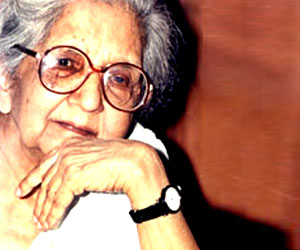Here is a brief biography and history of Aruna Asaf
Ali. Read information on life of Indian freedom fighter Aruna Asaf Ali.
Aruna Asaf Ali Biography

Born: July 16, 1909
Died: July 29, 1996
Achievements: Aruna Asaf Ali played a leading role during Quit
India Movement; elected as Delhi’s first Mayor; awarded the Lenin
Prize for peace in 1975 and the Jawahar Lal Nehru award for
International understanding for 1991; honored with Bharat Ratna in 1998.
Aruna Asaf Ali was a legendary heroine of India's freedom struggle. Her
moment of reckoning came in 1942 during Quit India Movement and she rose
to the occasion. She unfurled the national flag at the Gowalia Tank
maidan to signify the commencement of the Quit India Movement and became
a legend for thousands of youth that rose to emulate her.
Aruna Asaf Ali was born as Aruna Ganguly on July 16 1909 in Kalka (Haryana)
in an orthodox Hindu Bengali family. She was educated at Sacred Heart Convent in Lahore,
and then in Nainital. After graduating from school,
she taught at the Gokhale Memorial School in Calcutta. In Allahabad, she
met her future husband, Asaf Ali,a prominent Congressman who was 23 years
older than her. They were married in 1928 against parental opposition
on the grounds of both religion and age.
As Asaf Ali was deeply involved with freedom struggle, after marriage
Aruna Asaf Ali too plunged into it. Her first major political action was
during the Salt Satyagraha in 1930 when she addressed public meetings
and led processions. British Government charged her for being a “vagrant”
and sentenced her to one year’s imprisonment. When political prisoners
were released in the aftermath of Gandhi-Irwin pact, Aruna was not released.
But a public agitation in favour of her release forced British government
to release her.
She was arrested again in 1932 and put in Tihar Jail. In Tihar Jail she
went on a hunger strike against the treatment meted out to political prisoners.
Her protest caused an improvement in conditions, but she herself was moved
to solitary confinement in Ambala. After her release, she dropped out
of the national movement for 10 years.
In 1942 she attended the Bombay Congress Session with her husband,
where the historic Quit India resolution was passed on 8th August. When
the Congress leaders were arrested on the day after this resolution was
passed, Aruna presided over the flag-hoisting ceremony at Gowalia Tank
Maidan in Bombay. She provided the spark that ignited the movement. She
became a full-time activist in the Quit India movement and went
underground to evade arrest. Her property was seized by the Government
and sold. The Government also announced Rs. 5000 reward for her capture.
Meanwhile, she fell ill and on hearing this Gandhiji advised her to
surrender. However, Aruna Asaf Ali surrendered herself only when the
warrants against her were cancelled on 26th January 1946.
At the time of independence Aruna Asaf Ali was a member of the Congress
Socialist Party, which until then had been part of the Congress
framework. In 1948, however, the socialists, including Aruna, formed a
socialist party of their own. In 1955 this group merged with Communist
Party of India and she became a member of its Central committee and a
Vice President of the All India Trade Union Congress. In 1958 she left
the Communist Party of India and was elected Delhi's first Mayor. she
rejoined the Congress party in 1964 but ceased to play any active part
in politics. She was awarded the Lenin Prize for peace in 1975 and the
Jawahar Lal Nehru award for International understanding for 1991. Aruna
Asaf Ali died on died July 29 1996. She was awarded India's highest
civilian award, the Bharat Ratna, and was honoured with a stamp issued
by the Indian Postal Service in 1998.


